#scrim empires design
Text
I decided to take a little break in general worldbuilding for Empires, and decided to design all of their banners!
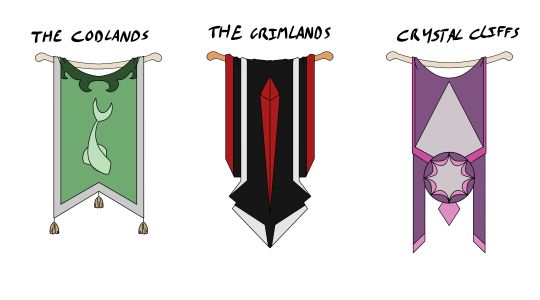
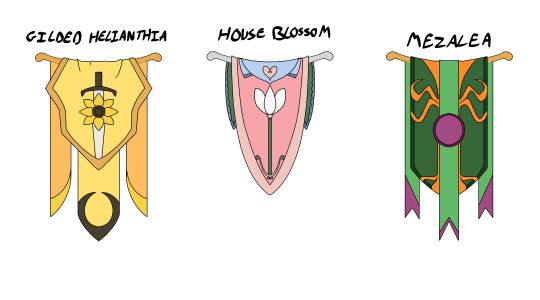
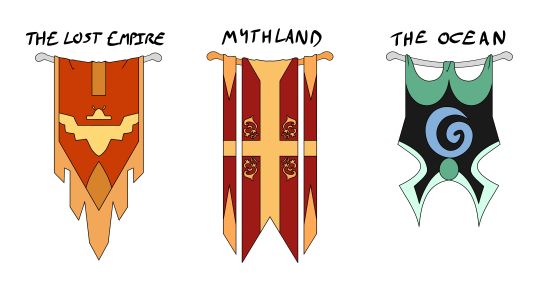
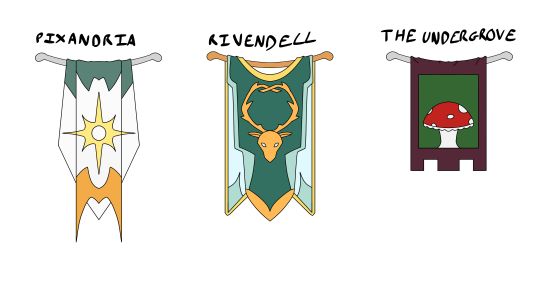
RIP the quality in advance (can't have my stuff too high quality or my laptop throws a hissy fit)
#art#drawing#empires smp#empires smp fanart#empiresblr#empires smp season 1#mcyt#mcyt fanart#I am not tagging the individual empires I dont even think they all have a tag#scrim's art#esmp#esmp s1#scrim empires design
1K notes
·
View notes
Text
"Tadao Ando's equivalent of what a dog does to a lamppost"
The redesign of Paris' Bourse de Commerce in Paris by architect Tadao Ando is a "complete disaster" of sterile concrete that turns the building into a monument to French colonial violence, says Aaron Betsky.
A billionaire and an architect walked into a bar. "What will you have?" the bartender asked. "Something to forget the evil origins of capitalism," the billionaire replied. "I need something to make me feel big and important," said the architect.
"I have the perfect thing for you," the bartender responded; "A concrete martini. It is round, dry, aseptic, and big enough to make you feel like you own the world."
"Make mine a double," the architect responded with enthusiasm.
That is how I imagine the origin story of the Pinault Collection's new venue in the Bourse, Paris' former stock exchange. It features a concrete ring whose functions, such as they are, appears to be to support two spindly staircases and some air outlets.
But its real nature seems to be architect Tadao Ando's equivalent of what a dog does to a lamppost, it is an example of money trying to transform itself into art and architecture at a gigantic scale. As a display space for a pretty good collection of contemporary art, it more or less succeeds. As an example of contemporary architecture, it is a complete disaster.
It is an example of money trying to transform itself into art and architecture at a gigantic scale.
The Bourse is a building of note. Its basic structure is that of the Halle aux blés, the grain exchange that it housed between 1767 and 1873. After its wooden dome burned down in 1802, Jean Francois Belanger redesigned it to offer not only a functional interior clothed with a classical exterior of great refinement but also to show off the new structure of iron and glass (ferrovitreous architecture, for the nerds) with great panache.
When it became the stock exchange in 1885, Henri Blondel redesigned it in a simpler manner, while five different artists added paintings around the central rotunda that glorified French colonial power. After years of neglect and misuse, the Bourse fell into the hands of one of France's two Titans of Luxury (the other being Bernard Arnault, who, although controlling the greater empire of LVMH, had to console himself with a somewhat better Frank Gehry building on the outskirts for his LVMH Foundation).
Pinault actually has an eye – or has eyes who work for him – and has thus built up a collection of contemporary art that is not only strong but also consistent, concentrating on representational work that ranges from the surreal to the evocative to the hyper-realistic. He collects in depth, and the galleries with work after work by Peter Doig, Marlene Dumas, David Hammons, or Kerry James Marshall are enough to make you forgive many (if not all) sins.
Unfortunately, Pinault also loves Tadao Ando, the former boxer whose work always photographs much better than it is. Ando, in turn, loves concrete and pure geometry. He does not seem to care where he puts his circles and squares. He works with clients, such as Pinault, who can help him assure that the concrete is as fine as marble. The two already strutted their stuff in Venice's Palazzo Grassi and Punta della Dogana, but now they have plunked themselves down in the heart of Paris.
It should have been a job of restoration and that effort has been done with great care by Pierre Antoine Gatier (France's Director of Historic Buildings) and a studio called NeM. The building and its decoration look as if they were finished a few days ago, and most new services have been tucked away with all the skill that good design and money can afford.
The only evidence of friction is the battalion of new lights hanging from the ceilings and the light that, despite scrims, rakes paintings with light. In the basement, the concrete continues as the walls of a small auditorium that is intimate and pleasant, while visitors have the chance to explore the original air conditioning equipment, which is as intricate and beautiful as any of the works of art on display above.
Obscuring everything but the dome, the circle creates a central space that I am sure will be great for parties.
If Ando had shown his generosity by concentrating on how all that worked and by adding those touches that would form an apt counterpoint to the existing structure, it would have been enough. However, he felt it necessary to follow up the work he did for Pinault in Venice by inserting the concrete walls that are his trademark. Here, they mainly take the form of a circle he erected on the former trading floor.
Obscuring everything but the dome, the circle creates a central space that I am sure will be great for parties, and that currently house a few nicely ironic sculptures that turn out to be melting candles, created by Urs Fischer.
Their other function is to provide a secondary staircase to the upper levels, and an outlet for air. The latter causes a lip to protrude that manages that only to ruin one's view of the architecture from the floor but does the same from the balconies above. There is no art hung on these massive walls.
Do we really have to look at Black people serving and doing obeisance to their conquerors one more time?
What that space really needs is not some Ando-ness, but some context or relativizing of the frieze on the dome above it. Do we really have to look at Black people serving and doing obeisance to their conquerors one more time, especially if it is in what is not a particularly good painting? Do we really need to stand in a sanitised place of exploitation through money, ironised only by wry sculptures, but monumentalised by architecture?
The artists whom Pinault has collected can hope that their messages, which are critical, evocative, and in some cases powerful beyond any Gucci bauble the billionaire can sell us, will cut through the conditions in which they are shown –although the white walls, fancy lights, and aestheticizing an in-your-face artist such as David Hammons confronts here makes you wonder about that.
The architect could have done a much better job digging, excavating, exposing, and confronting the two centuries of material present here. Instead, Ando not only drank his concrete martini but created an affectless tomb for all those who suffered and died to make this display possible.
The main photo is by Patrick Tourneboeuf.
Aaron Betsky is director of Virginia Tech School of Architecture and Design and was president of the School of Architecture at Taliesin from 2017 to 2019. A critic of art, architecture, and design, Betsky is the author of over a dozen books on those subjects, including a forthcoming survey of modernism in architecture and design. Trained as an architect and in the humanities at Yale University, Betsky was previously director of the Cincinnati Art Museum (2006-2014) and the Netherlands Architecture Institute (2001-2006), and curator of architecture and design at the San Francisco Museum of Modern Art (1995-2001). In 2008, he directed the 11th Venice International Biennale of Architecture.
The post "Tadao Ando's equivalent of what a dog does to a lamppost" appeared first on Dezeen.
0 notes
Text
The best furniture of 2017 – mirrored furniture versus fabric furniture
If you’re contemplating between mirrored furniture and upholstered furniture, you may need some quick information to make the decision. Each of these two options leaves a unique sense of style being complete polar opposites but also comes with a number of pros and cons. Mirrored furniture has been in use since the early 1900s, mostly loved for its ability to evoke the glamor of royal luxury and perfectly blend in with any décor as it reflects the beauty of the surroundings. Upholstered furniture, on the other hand, offers a touch of sophistication and comfort, mostly loved for its ambient and diversity in colors and texture. Let’s take a closer look at each of them below.
Mirrored furniture
For thousands of years, long before the inventions of a mirror, our ancestors used to gaze at still pools of water to see their reflections. This was also before the invention of polished bronze and copper. The invention of the first glass was by the Roman Empire in the 12th century. Aside from self-admiration, pieces of mirrors were later incorporated into various items and furniture as the mirror making technology advanced. Mirrored furniture was first popularized in the 1920s but was limited to a few items.
Today, almost every piece of furniture has its mirrored version that is just as appealing and even more beautiful. Mirrored furniture is pretty much any piece of furniture made wholly or partly from glass materials. Most often they are the most adorable items in the house and consist of things like dressing tables, buffets tables, makeup tables, coffee tables, kitchen cabinets and so on. All these and much more are usually very nicely crafted and designed to last.
Some of the mirrored furniture is encased in wood, metal or plastic frames. Each mirrored furniture item is a beautiful and perfect way to highlight sections of a room. Most people find mirrored furniture to be a perfect way to create a sense of space and light whilst offering a touch of timeless glamor. The reflective design associated with mirrored furniture is suitable for various rooms in your home from living room to the bedroom.
Any luxuriously decorated homes can’t be complete without a hint of mirrored furniture.
Pros and cons of mirrored furniture
Pros
• Excellent appearance: Mirrored furniture always looks beautiful and can decorate any room, highlight it and make it the center of attention. It also fits in any style of interior décor.
• Offers visual extension of space: The transparency and ability to reflect light make mirrored furniture almost invisible, which makes any room brighter and wider.
• Safe and reliable: Glasses and mirrors used to create this kind of furniture are nowadays given a special treatment that makes them impact-resistant and long lasting.
Cons
• They need daily care as any signs of fingerprints, dust, spray or utensil marks are visible.
• Glass doors and tabletops often open up view of items undesirable for all to see.
Upholstered furniture
Upholstered furniture is another definition for comfort, style, and luxury combined. It offers a good level of cushioning and is always enclosed in leather or fabric. It also has wooden or steel frame that complement the color and design of the fabric used. Before the proliferation of upholstered furniture in the 18th century, upholsters provided textiles, upholstery, and fittings for funerals. In the early 1840s, many traders in USA and England created upholster furniture centers some of which are still operational to date.
Furniture upholstery and re-upholstery companies continue to thrive with various businesses large and small offering these services. Today furniture upholstery uses a wide range of materials for covering and padding chairs, sofas, and seats. Some of these materials include lashings, springs, stuffings of animal hair, coir and grasses, wools, scrims, vinyl, linen, hessian, bridle ties, stuffing ties and so on. There are countless designs and types of upholstered furniture ranging from single sofas, living room chairs, double or triple seater sofas, couches, and more. The furniture also comes with fine finishing that allows us to make perfect color, design and pattern combination.
Upholstery furniture is also long lasting and easy to maintain; with a vacuum cleaner, you can ensure a great look for your living room.
Pros and cons of upholstered furniture
Pros
• Variety: Upholstered furniture comes in a variety of colors, textures, designs, and patterns that complement your interior décor
• Comfort: Aside from ambiance, they are the most comfortable furniture items with cushions and padding to make your rest worthwhile.
• Pleasing to touch, easy to care for, durable and resistant to average abrasion
Cons
• Some materials used for upholstering are highly flammable if not treated
• Poor resistance to stains and moisture
Conclusion From the above quick look through the two furniture options, you should have already made your decision by now. But of course, this will depend on things like your taste and preferences, budget, existing interior décor, and so on. You, however, don’t necessarily have to choose one over the other; you can as well combine the two styles to get the benefits of both sides.
So I presume you now want to see some examples of each?
Red fabric cushioned bed that is certainly very eye catching and bold
A decorative mirrored bed that is certainly unique and not often seen in homes
An antique style wooden bed with luxurious fabric padding
A bed with a unique blend of both mirrored and fabric design elements
So where can you buy the best looking items of whichever type you prefer?
We would prefer you go for the fabric types because that's our line of work but that would be a biased view so please have look at these reputable suppliers and see which you prefer.
Upholstered Furniture Suppliers
Lazboy
Ashley Home Store
Macys
Mirrored Furniture Suppliers
Pier 1
Homes Direct 365
Target
The post The best furniture of 2017 – mirrored furniture versus fabric furniture is available on http://coats-viyella.co.uk
0 notes
Text
The Ocean Queen Lizzie, in both her forms


(Lore under the cut)
Most of the population of the ocean live in its depths. At the beginning, the Queen builds the prisma Palace for herself and her rule, as her people need no help with their homes or their protection.
The Ocean is the most mysterious of all the domains; why does a random human decide to lead them, and why do the hybrids of the ocean let her? This goes unexplained until the truth of the past is, in part revealed
#art#empires#empires smp#empires s1#empires smp season one#empires smp lizzie#empires smp ocean queen#ldshadowlady#lizzie ldshadowlady#ldshadowlady fanart#scrim's art#scrim empires design
245 notes
·
View notes
Text
Codfather Solidarity design!

(Closeups and lore under the cut)
The Codfather (a gender neutral position and title) is the leader of the Codlands/Mystic Swamps. There is no lineage to this title, as it is earned.
The Codfather must cover their face and not speak their name, except to those close to them, instead choosing a title for themselves. This is for the sense that the Codfather is a representative of the people and their wishes.


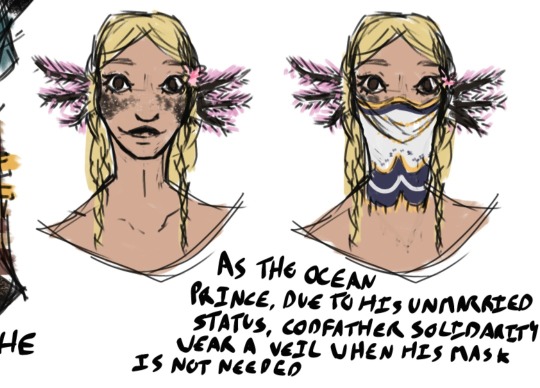
#art#drawing#character design#digital art#empires smp#empires jimmy#empires smp jimmy#empires smp season 1#empires smp headcanon#the codfather#my art#scrim's art#scrim empires design
156 notes
·
View notes
Text
Wizard Gem design!
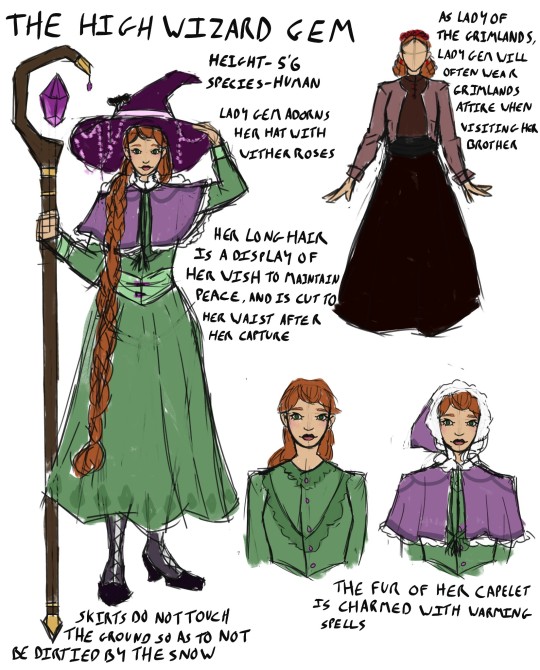
Closeups and lore under the cut!



The Wizard Gem, twin to Count Fwhip of the Grimlands, opted to join the Crystal Cliffs Academy when she was a teenager, as she would not be inheriting the Grimlands
Since then, she oversaw as the Crystal Cliffs because more significant, and the spirit of the land Chose her - making them on par with the kingdoms around it
Still, they are not of royalty (although Gem still is herself), although many councils will employ wizards as advisers. They are peaceful, and so refuse to be used as soldiers or generals
#art#drawing#character design#digital art#empires smp#empires smp fanart#empires smp gem#geminitay fanart#geminitay#scrim's art#scrim empires design
99 notes
·
View notes
Text
Hello. It's 1am

(Lore under the cut)
In Rivendell, gold is a common sight. It is believed to have properties that can protect and purify. As such, the kingdom slowly became the richest in the land - elves live long, and so they had the time
Rivendell is also the oldest domain, unless you count the ocean itself and the ender dragon
The stag is sacred in Rivendell, and deer of any kind are unacceptable to kill. Antler symbols can be found everywhere as a symbol of protection
#art#empires#empires smp#empires smp fanart#scott smajor#dangthatsalongname#scott smajor fanart#scrim's art#scrim empires design
25 notes
·
View notes
Text
Count Fwhip design!

(Closeups and lore under the cut)

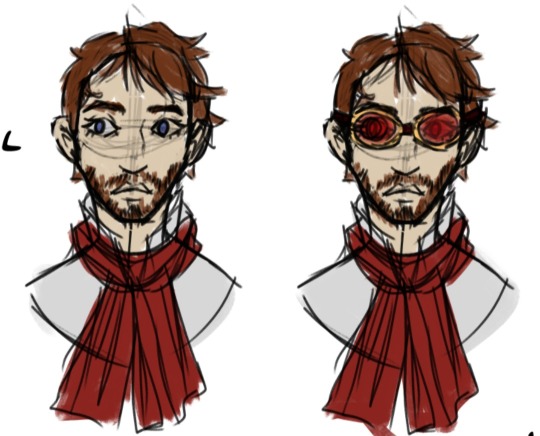
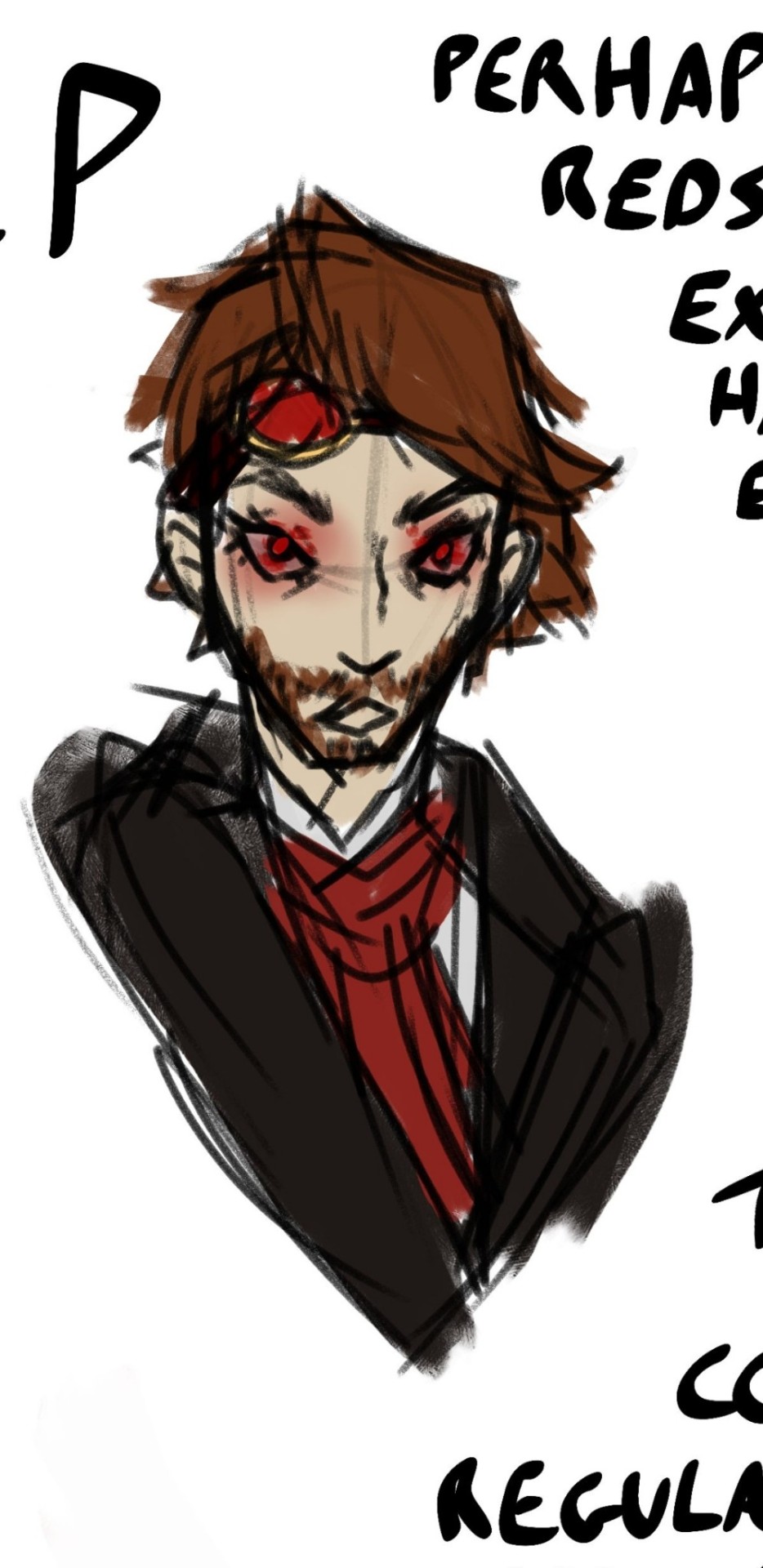

Count Fwhip, the elder of him and his sister Gem, was the youngest Count of the Grimlands in recent memory, as he became Count at a mere 17 years of age
Known as the 'Tinkerer', the Count enjoys the magic offered by redstone crystals and dust rather than spells. He can often be found in his workshop, and it is wise not to interrupt him, for some say he is slightly mad - whether this is true, he does have quite the temper and foul side
He will clean up for dances, but will usually be found anywhere but the dance floor. It is said he has a distaste due to the importance of dance to the Coddish, however this is just because he can't dance
#art#drawing#character design#empires smp#empires smp season 1#empires smp fwhip#fwhip#empires fwhip#count fwhip#the grimlands#scrim's art#scrim empires design
50 notes
·
View notes
Text
Dame Katherine, Guardian of the Spring and The Overgrown

(This is the first time that I will apologise for my handwriting)
(Lore under the cut)
The ruler of the Overgrown is always chosen by the Spring, although the reasons why they are chosen seem to always differ. In Katherine's case, it seems that her neutral stance on conflict was a large part of this, as she is Dame in an uncertain time
Hair and wings are very important in fae culture; hair shows age (and presumably wisdom) while wings, the most delicate part of the body, are protected and showed off. It is very tacky to wear clothes that clash with your wings
8 notes
·
View notes
Text
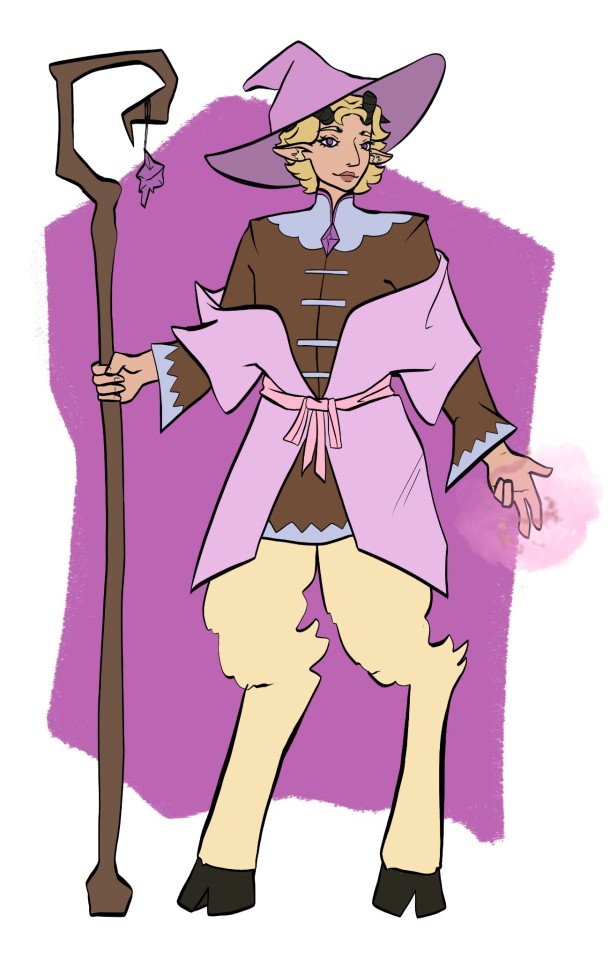
Week three of @shepscapades hermit design challenge!
Here we have Wizard Zedaph of the Crystal Cliffs! The High Wizard's first advisor, who every other advisor advises against because he's a bit wacky.
He's not scared of Xornoth, and is also pretty immune to his powers.
#shepshermitdesign23#art#drawing#character design#digital art#hermitcraft#hermitcraft fanart#empires smp#empires smp season 1#zedaph#zedaphplays#zedaph fanart#my art#scrim's art
88 notes
·
View notes
Text
Based on @chrisrin 's gemcyt au designs, and @sporesdoingart 's own design, here is my seablings fushion design!

Pronouns: he/she
Stable, can stay fused for long periods of time
Will talk to herself back and forth like a conversation (think Stevonnie when they first fused)
126 notes
·
View notes
Text
Me drawing any empires character: well I don't want to stray too far from canon
My Codfather design, the most oc fanart I've ever done: ...
29 notes
·
View notes
Text
"Tadao Ando's equivalent of what a dog does to a lamppost"
The redesign of Paris' Bourse de Commerce in Paris by architect Tadao Ando is a "complete disaster" of sterile concrete that turns the building into a monument to French colonial violence, says Aaron Betsky.
A billionaire and an architect walked into a bar. "What will you have?" the bartender asked. "Something to forget the evil origins of capitalism," the billionaire replied. "I need something to make me feel big and important," said the architect.
"I have the perfect thing for you," the bartender responded; "A concrete martini. It is round, dry, aseptic, and big enough to make you feel like you own the world."
"Make mine a double," the architect responded with enthusiasm.
That is how I imagine the origin story of the Pinault Collection's new venue in the Bourse, Paris' former stock exchange. It features a concrete ring whose functions, such as they are, appears to be to support two spindly staircases and some air outlets.
But its real nature seems to be architect Tadao Ando's equivalent of what a dog does to a lamppost, it is an example of money trying to transform itself into art and architecture at a gigantic scale. As a display space for a pretty good collection of contemporary art, it more or less succeeds. As an example of contemporary architecture, it is a complete disaster.
It is an example of money trying to transform itself into art and architecture at a gigantic scale.
The Bourse is a building of note. Its basic structure is that of the Halle aux blés, the grain exchange that it housed between 1767 and 1873. After its wooden dome burned down in 1802, Jean Francois Belanger redesigned it to offer not only a functional interior clothed with a classical exterior of great refinement but also to show off the new structure of iron and glass (ferrovitreous architecture, for the nerds) with great panache.
When it became the stock exchange in 1885, Henri Blondel redesigned it in a simpler manner, while five different artists added paintings around the central rotunda that glorified French colonial power. After years of neglect and misuse, the Bourse fell into the hands of one of France's two Titans of Luxury (the other being Bernard Arnault, who, although controlling the greater empire of LVMH, had to console himself with a somewhat better Frank Gehry building on the outskirts for his LVMH Foundation).
Pinault actually has an eye – or has eyes who work for him – and has thus built up a collection of contemporary art that is not only strong but also consistent, concentrating on representational work that ranges from the surreal to the evocative to the hyper-realistic. He collects in depth, and the galleries with work after work by Peter Doig, Marlene Dumas, David Hammons, or Kerry James Marshall are enough to make you forgive many (if not all) sins.
Unfortunately, Pinault also loves Tadao Ando, the former boxer whose work always photographs much better than it is. Ando, in turn, loves concrete and pure geometry. He does not seem to care where he puts his circles and squares. He works with clients, such as Pinault, who can help him assure that the concrete is as fine as marble. The two already strutted their stuff in Venice's Palazzo Grassi and Punta della Dogana, but now they have plunked themselves down in the heart of Paris.
It should have been a job of restoration and that effort has been done with great care by Pierre Antoine Gatier (France's Director of Historic Buildings) and a studio called NeM. The building and its decoration look as if they were finished a few days ago, and most new services have been tucked away with all the skill that good design and money can afford.
The only evidence of friction is the battalion of new lights hanging from the ceilings and the light that, despite scrims, rakes paintings with light. In the basement, the concrete continues as the walls of a small auditorium that is intimate and pleasant, while visitors have the chance to explore the original air conditioning equipment, which is as intricate and beautiful as any of the works of art on display above.
Obscuring everything but the dome, the circle creates a central space that I am sure will be great for parties.
If Ando had shown his generosity by concentrating on how all that worked and by adding those touches that would form an apt counterpoint to the existing structure, it would have been enough. However, he felt it necessary to follow up the work he did for Pinault in Venice by inserting the concrete walls that are his trademark. Here, they mainly take the form of a circle he erected on the former trading floor.
Obscuring everything but the dome, the circle creates a central space that I am sure will be great for parties, and that currently house a few nicely ironic sculptures that turn out to be melting candles, created by Urs Fischer.
Their other function is to provide a secondary staircase to the upper levels, and an outlet for air. The latter causes a lip to protrude that manages that only to ruin one's view of the architecture from the floor but does the same from the balconies above. There is no art hung on these massive walls.
Do we really have to look at Black people serving and doing obeisance to their conquerors one more time?
What that space really needs is not some Ando-ness, but some context or relativizing of the frieze on the dome above it. Do we really have to look at Black people serving and doing obeisance to their conquerors one more time, especially if it is in what is not a particularly good painting? Do we really need to stand in a sanitised place of exploitation through money, ironised only by wry sculptures, but monumentalised by architecture?
The artists whom Pinault has collected can hope that their messages, which are critical, evocative, and in some cases powerful beyond any Gucci bauble the billionaire can sell us, will cut through the conditions in which they are shown –although the white walls, fancy lights, and aestheticizing an in-your-face artist such as David Hammons confronts here makes you wonder about that.
The architect could have done a much better job digging, excavating, exposing, and confronting the two centuries of material present here. Instead, Ando not only drank his concrete martini but created an affectless tomb for all those who suffered and died to make this display possible.
The main photo is by Patrick Tourneboeuf.
Aaron Betsky is director of Virginia Tech School of Architecture and Design and was president of the School of Architecture at Taliesin from 2017 to 2019. A critic of art, architecture, and design, Betsky is the author of over a dozen books on those subjects, including a forthcoming survey of modernism in architecture and design. Trained as an architect and in the humanities at Yale University, Betsky was previously director of the Cincinnati Art Museum (2006-2014) and the Netherlands Architecture Institute (2001-2006), and curator of architecture and design at the San Francisco Museum of Modern Art (1995-2001). In 2008, he directed the 11th Venice International Biennale of Architecture.
The post "Tadao Ando's equivalent of what a dog does to a lamppost" appeared first on Dezeen.
0 notes
Text
"Tadao Ando's equivalent of what a dog does to a lamppost"
The redesign of Paris' Bourse de Commerce in Paris by architect Tadao Ando is a "complete disaster" of sterile concrete that turns the building into a monument to French colonial violence, says Aaron Betsky.
A billionaire and an architect walked into a bar. "What will you have?" the bartender asked. "Something to forget the evil origins of capitalism," the billionaire replied. "I need something to make me feel big and important," said the architect.
"I have the perfect thing for you," the bartender responded; "A concrete martini. It is round, dry, aseptic, and big enough to make you feel like you own the world."
"Make mine a double," the architect responded with enthusiasm.
That is how I imagine the origin story of the Pinault Collection's new venue in the Bourse, Paris' former stock exchange. It features a concrete ring whose functions, such as they are, appears to be to support two spindly staircases and some air outlets.
But its real nature seems to be architect Tadao Ando's equivalent of what a dog does to a lamppost, it is an example of money trying to transform itself into art and architecture at a gigantic scale. As a display space for a pretty good collection of contemporary art, it more or less succeeds. As an example of contemporary architecture, it is a complete disaster.
It is an example of money trying to transform itself into art and architecture at a gigantic scale.
The Bourse is a building of note. Its basic structure is that of the Halle aux blés, the grain exchange that it housed between 1767 and 1873. After its wooden dome burned down in 1802, Jean Francois Belanger redesigned it to offer not only a functional interior clothed with a classical exterior of great refinement but also to show off the new structure of iron and glass (ferrovitreous architecture, for the nerds) with great panache.
When it became the stock exchange in 1885, Henri Blondel redesigned it in a simpler manner, while five different artists added paintings around the central rotunda that glorified French colonial power. After years of neglect and misuse, the Bourse fell into the hands of one of France's two Titans of Luxury (the other being Bernard Arnault, who, although controlling the greater empire of LVMH, had to console himself with a somewhat better Frank Gehry building on the outskirts for his LVMH Foundation).
Pinault actually has an eye – or has eyes who work for him – and has thus built up a collection of contemporary art that is not only strong but also consistent, concentrating on representational work that ranges from the surreal to the evocative to the hyper-realistic. He collects in depth, and the galleries with work after work by Peter Doig, Marlene Dumas, David Hammons, or Kerry James Marshall are enough to make you forgive many (if not all) sins.
Unfortunately, Pinault also loves Tadao Ando, the former boxer whose work always photographs much better than it is. Ando, in turn, loves concrete and pure geometry. He does not seem to care where he puts his circles and squares. He works with clients, such as Pinault, who can help him assure that the concrete is as fine as marble. The two already strutted their stuff in Venice's Palazzo Grassi and Punta della Dogana, but now they have plunked themselves down in the heart of Paris.
It should have been a job of restoration and that effort has been done with great care by Pierre Antoine Gatier (France's Director of Historic Buildings) and a studio called NeM. The building and its decoration look as if they were finished a few days ago, and most new services have been tucked away with all the skill that good design and money can afford.
The only evidence of friction is the battalion of new lights hanging from the ceilings and the light that, despite scrims, rakes paintings with light. In the basement, the concrete continues as the walls of a small auditorium that is intimate and pleasant, while visitors have the chance to explore the original air conditioning equipment, which is as intricate and beautiful as any of the works of art on display above.
Obscuring everything but the dome, the circle creates a central space that I am sure will be great for parties.
If Ando had shown his generosity by concentrating on how all that worked and by adding those touches that would form an apt counterpoint to the existing structure, it would have been enough. However, he felt it necessary to follow up the work he did for Pinault in Venice by inserting the concrete walls that are his trademark. Here, they mainly take the form of a circle he erected on the former trading floor.
Obscuring everything but the dome, the circle creates a central space that I am sure will be great for parties, and that currently house a few nicely ironic sculptures that turn out to be melting candles, created by Urs Fischer.
Their other function is to provide a secondary staircase to the upper levels, and an outlet for air. The latter causes a lip to protrude that manages that only to ruin one's view of the architecture from the floor but does the same from the balconies above. There is no art hung on these massive walls.
Do we really have to look at Black people serving and doing obeisance to their conquerors one more time?
What that space really needs is not some Ando-ness, but some context or relativizing of the frieze on the dome above it. Do we really have to look at Black people serving and doing obeisance to their conquerors one more time, especially if it is in what is not a particularly good painting? Do we really need to stand in a sanitised place of exploitation through money, ironised only by wry sculptures, but monumentalised by architecture?
The artists whom Pinault has collected can hope that their messages, which are critical, evocative, and in some cases powerful beyond any Gucci bauble the billionaire can sell us, will cut through the conditions in which they are shown –although the white walls, fancy lights, and aestheticizing an in-your-face artist such as David Hammons confronts here makes you wonder about that.
The architect could have done a much better job digging, excavating, exposing, and confronting the two centuries of material present here. Instead, Ando not only drank his concrete martini but created an affectless tomb for all those who suffered and died to make this display possible.
The main photo is by Patrick Tourneboeuf.
Aaron Betsky is director of Virginia Tech School of Architecture and Design and was president of the School of Architecture at Taliesin from 2017 to 2019. A critic of art, architecture, and design, Betsky is the author of over a dozen books on those subjects, including a forthcoming survey of modernism in architecture and design. Trained as an architect and in the humanities at Yale University, Betsky was previously director of the Cincinnati Art Museum (2006-2014) and the Netherlands Architecture Institute (2001-2006), and curator of architecture and design at the San Francisco Museum of Modern Art (1995-2001). In 2008, he directed the 11th Venice International Biennale of Architecture.
The post "Tadao Ando's equivalent of what a dog does to a lamppost" appeared first on Dezeen.
0 notes
Text
"Tadao Ando's equivalent of what a dog does to a lamppost"
The redesign of Paris' Bourse de Commerce in Paris by architect Tadao Ando is a "complete disaster" of sterile concrete that turns the building into a monument to French colonial violence, says Aaron Betsky.
A billionaire and an architect walked into a bar. "What will you have?" the bartender asked. "Something to forget the evil origins of capitalism," the billionaire replied. "I need something to make me feel big and important," said the architect.
"I have the perfect thing for you," the bartender responded; "A concrete martini. It is round, dry, aseptic, and big enough to make you feel like you own the world."
"Make mine a double," the architect responded with enthusiasm.
That is how I imagine the origin story of the Pinault Collection's new venue in the Bourse, Paris' former stock exchange. It features a concrete ring whose functions, such as they are, appears to be to support two spindly staircases and some air outlets.
But its real nature seems to be architect Tadao Ando's equivalent of what a dog does to a lamppost, it is an example of money trying to transform itself into art and architecture at a gigantic scale. As a display space for a pretty good collection of contemporary art, it more or less succeeds. As an example of contemporary architecture, it is a complete disaster.
It is an example of money trying to transform itself into art and architecture at a gigantic scale.
The Bourse is a building of note. Its basic structure is that of the Halle aux blés, the grain exchange that it housed between 1767 and 1873. After its wooden dome burned down in 1802, Jean Francois Belanger redesigned it to offer not only a functional interior clothed with a classical exterior of great refinement but also to show off the new structure of iron and glass (ferrovitreous architecture, for the nerds) with great panache.
When it became the stock exchange in 1885, Henri Blondel redesigned it in a simpler manner, while five different artists added paintings around the central rotunda that glorified French colonial power. After years of neglect and misuse, the Bourse fell into the hands of one of France's two Titans of Luxury (the other being Bernard Arnault, who, although controlling the greater empire of LVMH, had to console himself with a somewhat better Frank Gehry building on the outskirts for his LVMH Foundation).
Pinault actually has an eye – or has eyes who work for him – and has thus built up a collection of contemporary art that is not only strong but also consistent, concentrating on representational work that ranges from the surreal to the evocative to the hyper-realistic. He collects in depth, and the galleries with work after work by Peter Doig, Marlene Dumas, David Hammons, or Kerry James Marshall are enough to make you forgive many (if not all) sins.
Unfortunately, Pinault also loves Tadao Ando, the former boxer whose work always photographs much better than it is. Ando, in turn, loves concrete and pure geometry. He does not seem to care where he puts his circles and squares. He works with clients, such as Pinault, who can help him assure that the concrete is as fine as marble. The two already strutted their stuff in Venice's Palazzo Grassi and Punta della Dogana, but now they have plunked themselves down in the heart of Paris.
It should have been a job of restoration and that effort has been done with great care by Pierre Antoine Gatier (France's Director of Historic Buildings) and a studio called NeM. The building and its decoration look as if they were finished a few days ago, and most new services have been tucked away with all the skill that good design and money can afford.
The only evidence of friction is the battalion of new lights hanging from the ceilings and the light that, despite scrims, rakes paintings with light. In the basement, the concrete continues as the walls of a small auditorium that is intimate and pleasant, while visitors have the chance to explore the original air conditioning equipment, which is as intricate and beautiful as any of the works of art on display above.
Obscuring everything but the dome, the circle creates a central space that I am sure will be great for parties.
If Ando had shown his generosity by concentrating on how all that worked and by adding those touches that would form an apt counterpoint to the existing structure, it would have been enough. However, he felt it necessary to follow up the work he did for Pinault in Venice by inserting the concrete walls that are his trademark. Here, they mainly take the form of a circle he erected on the former trading floor.
Obscuring everything but the dome, the circle creates a central space that I am sure will be great for parties, and that currently house a few nicely ironic sculptures that turn out to be melting candles, created by Urs Fischer.
Their other function is to provide a secondary staircase to the upper levels, and an outlet for air. The latter causes a lip to protrude that manages that only to ruin one's view of the architecture from the floor but does the same from the balconies above. There is no art hung on these massive walls.
Do we really have to look at Black people serving and doing obeisance to their conquerors one more time?
What that space really needs is not some Ando-ness, but some context or relativizing of the frieze on the dome above it. Do we really have to look at Black people serving and doing obeisance to their conquerors one more time, especially if it is in what is not a particularly good painting? Do we really need to stand in a sanitised place of exploitation through money, ironised only by wry sculptures, but monumentalised by architecture?
The artists whom Pinault has collected can hope that their messages, which are critical, evocative, and in some cases powerful beyond any Gucci bauble the billionaire can sell us, will cut through the conditions in which they are shown –although the white walls, fancy lights, and aestheticizing an in-your-face artist such as David Hammons confronts here makes you wonder about that.
The architect could have done a much better job digging, excavating, exposing, and confronting the two centuries of material present here. Instead, Ando not only drank his concrete martini but created an affectless tomb for all those who suffered and died to make this display possible.
The main photo is by Patrick Tourneboeuf.
Aaron Betsky is director of Virginia Tech School of Architecture and Design and was president of the School of Architecture at Taliesin from 2017 to 2019. A critic of art, architecture, and design, Betsky is the author of over a dozen books on those subjects, including a forthcoming survey of modernism in architecture and design. Trained as an architect and in the humanities at Yale University, Betsky was previously director of the Cincinnati Art Museum (2006-2014) and the Netherlands Architecture Institute (2001-2006), and curator of architecture and design at the San Francisco Museum of Modern Art (1995-2001). In 2008, he directed the 11th Venice International Biennale of Architecture.
The post "Tadao Ando's equivalent of what a dog does to a lamppost" appeared first on Dezeen.
0 notes
Text
"Tadao Ando's equivalent of what a dog does to a lamppost"
The redesign of Paris' Bourse de Commerce in Paris by architect Tadao Ando is a "complete disaster" of sterile concrete that turns the building into a monument to French colonial violence, says Aaron Betsky.
A billionaire and an architect walked into a bar. "What will you have?" the bartender asked. "Something to forget the evil origins of capitalism," the billionaire replied. "I need something to make me feel big and important," said the architect.
"I have the perfect thing for you," the bartender responded; "A concrete martini. It is round, dry, aseptic, and big enough to make you feel like you own the world."
"Make mine a double," the architect responded with enthusiasm.
That is how I imagine the origin story of the Pinault Collection's new venue in the Bourse, Paris' former stock exchange. It features a concrete ring whose functions, such as they are, appears to be to support two spindly staircases and some air outlets.
But its real nature seems to be architect Tadao Ando's equivalent of what a dog does to a lamppost, it is an example of money trying to transform itself into art and architecture at a gigantic scale. As a display space for a pretty good collection of contemporary art, it more or less succeeds. As an example of contemporary architecture, it is a complete disaster.
It is an example of money trying to transform itself into art and architecture at a gigantic scale.
The Bourse is a building of note. Its basic structure is that of the Halle aux blés, the grain exchange that it housed between 1767 and 1873. After its wooden dome burned down in 1802, Jean Francois Belanger redesigned it to offer not only a functional interior clothed with a classical exterior of great refinement but also to show off the new structure of iron and glass (ferrovitreous architecture, for the nerds) with great panache.
When it became the stock exchange in 1885, Henri Blondel redesigned it in a simpler manner, while five different artists added paintings around the central rotunda that glorified French colonial power. After years of neglect and misuse, the Bourse fell into the hands of one of France's two Titans of Luxury (the other being Bernard Arnault, who, although controlling the greater empire of LVMH, had to console himself with a somewhat better Frank Gehry building on the outskirts for his LVMH Foundation).
Pinault actually has an eye – or has eyes who work for him – and has thus built up a collection of contemporary art that is not only strong but also consistent, concentrating on representational work that ranges from the surreal to the evocative to the hyper-realistic. He collects in depth, and the galleries with work after work by Peter Doig, Marlene Dumas, David Hammons, or Kerry James Marshall are enough to make you forgive many (if not all) sins.
Unfortunately, Pinault also loves Tadao Ando, the former boxer whose work always photographs much better than it is. Ando, in turn, loves concrete and pure geometry. He does not seem to care where he puts his circles and squares. He works with clients, such as Pinault, who can help him assure that the concrete is as fine as marble. The two already strutted their stuff in Venice's Palazzo Grassi and Punta della Dogana, but now they have plunked themselves down in the heart of Paris.
It should have been a job of restoration and that effort has been done with great care by Pierre Antoine Gatier (France's Director of Historic Buildings) and a studio called NeM. The building and its decoration look as if they were finished a few days ago, and most new services have been tucked away with all the skill that good design and money can afford.
The only evidence of friction is the battalion of new lights hanging from the ceilings and the light that, despite scrims, rakes paintings with light. In the basement, the concrete continues as the walls of a small auditorium that is intimate and pleasant, while visitors have the chance to explore the original air conditioning equipment, which is as intricate and beautiful as any of the works of art on display above.
Obscuring everything but the dome, the circle creates a central space that I am sure will be great for parties.
If Ando had shown his generosity by concentrating on how all that worked and by adding those touches that would form an apt counterpoint to the existing structure, it would have been enough. However, he felt it necessary to follow up the work he did for Pinault in Venice by inserting the concrete walls that are his trademark. Here, they mainly take the form of a circle he erected on the former trading floor.
Obscuring everything but the dome, the circle creates a central space that I am sure will be great for parties, and that currently house a few nicely ironic sculptures that turn out to be melting candles, created by Urs Fischer.
Their other function is to provide a secondary staircase to the upper levels, and an outlet for air. The latter causes a lip to protrude that manages that only to ruin one's view of the architecture from the floor but does the same from the balconies above. There is no art hung on these massive walls.
Do we really have to look at Black people serving and doing obeisance to their conquerors one more time?
What that space really needs is not some Ando-ness, but some context or relativizing of the frieze on the dome above it. Do we really have to look at Black people serving and doing obeisance to their conquerors one more time, especially if it is in what is not a particularly good painting? Do we really need to stand in a sanitised place of exploitation through money, ironised only by wry sculptures, but monumentalised by architecture?
The artists whom Pinault has collected can hope that their messages, which are critical, evocative, and in some cases powerful beyond any Gucci bauble the billionaire can sell us, will cut through the conditions in which they are shown –although the white walls, fancy lights, and aestheticizing an in-your-face artist such as David Hammons confronts here makes you wonder about that.
The architect could have done a much better job digging, excavating, exposing, and confronting the two centuries of material present here. Instead, Ando not only drank his concrete martini but created an affectless tomb for all those who suffered and died to make this display possible.
The main photo is by Patrick Tourneboeuf.
Aaron Betsky is director of Virginia Tech School of Architecture and Design and was president of the School of Architecture at Taliesin from 2017 to 2019. A critic of art, architecture, and design, Betsky is the author of over a dozen books on those subjects, including a forthcoming survey of modernism in architecture and design. Trained as an architect and in the humanities at Yale University, Betsky was previously director of the Cincinnati Art Museum (2006-2014) and the Netherlands Architecture Institute (2001-2006), and curator of architecture and design at the San Francisco Museum of Modern Art (1995-2001). In 2008, he directed the 11th Venice International Biennale of Architecture.
The post "Tadao Ando's equivalent of what a dog does to a lamppost" appeared first on Dezeen.
0 notes